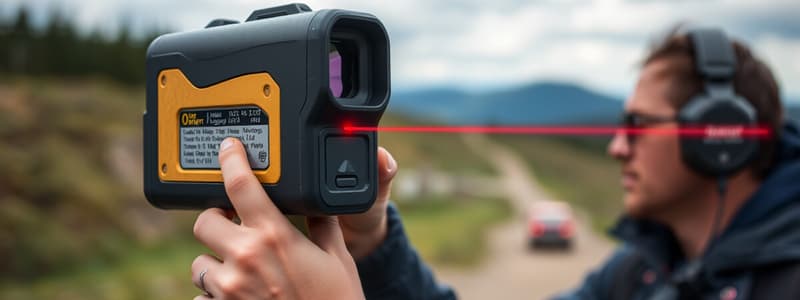Podcast
Questions and Answers
What action should be taken if a 'Supply LO' message is displayed on the LRF?
What action should be taken if a 'Supply LO' message is displayed on the LRF?
Which statement is true regarding the use of a tripod stand with the LRF?
Which statement is true regarding the use of a tripod stand with the LRF?
What should an operator do if they encounter a 'Comm ERRS' message on the LRF?
What should an operator do if they encounter a 'Comm ERRS' message on the LRF?
Which of the following is NOT a recommended maintenance practice for the Laser Range Finder?
Which of the following is NOT a recommended maintenance practice for the Laser Range Finder?
Signup and view all the answers
While using the LRF to determine visibility landmarks, what precaution should be taken for measurements under 1 km?
While using the LRF to determine visibility landmarks, what precaution should be taken for measurements under 1 km?
Signup and view all the answers
What is the primary function of the Laser Range Finder (LRF)?
What is the primary function of the Laser Range Finder (LRF)?
Signup and view all the answers
Which accessory is recommended for optimal performance of the LRF for distances less than or equal to 1 km?
Which accessory is recommended for optimal performance of the LRF for distances less than or equal to 1 km?
Signup and view all the answers
Which aspect of the Laser Range Finder is related to its power supply?
Which aspect of the Laser Range Finder is related to its power supply?
Signup and view all the answers
What is the maximum range of the Laser Range Finder as specified?
What is the maximum range of the Laser Range Finder as specified?
Signup and view all the answers
What is the minimum range of the Laser Range Finder, and what accessory is recommended for this range?
What is the minimum range of the Laser Range Finder, and what accessory is recommended for this range?
Signup and view all the answers
How often can the LRF take measurements during its duty cycle in the first 2 minutes?
How often can the LRF take measurements during its duty cycle in the first 2 minutes?
Signup and view all the answers
Why might the LRF be used in meteorology?
Why might the LRF be used in meteorology?
Signup and view all the answers
What should be done if the battery charger is unable to charge a battery?
What should be done if the battery charger is unable to charge a battery?
Signup and view all the answers
Which component of the Laser Range Finder displays the calculated distance?
Which component of the Laser Range Finder displays the calculated distance?
Signup and view all the answers
How can the battery charger manage charging efficiency?
How can the battery charger manage charging efficiency?
Signup and view all the answers
Study Notes
Laser Range Finder (LRF) Overview
- LRF measures distance to objects using a laser beam which, when emitted, reflects off the target back to the device.
- In meteorology, LRF is utilized to measure cloud height based on the time taken for the laser to return, yielding the distance displayed in meters.
Error Messages and Indicators
- NSP (No Start Pulse): Indicates a malfunction in the LRF.
- NO MAXR (No Maximum Range): Suggests a problem with the LRF.
- Supply LO (Supply Low): Indicates the LRF battery needs recharging or replacement.
- Comm ERRS (Communication Error): Signifies a failure in communication between the LRF and RCU, preventing joint operation.
Safety Precautions
- Laser light from the LRF can severely damage eyesight, requiring strict adherence to safety measures.
- Proper handling of equipment is essential, including checking battery voltage before insertion, removing batteries when not in use, and regular monthly charging.
- Using a rubber or metallic lens cover when the device is idle helps protect the optics.
Operational Guidelines
- An attenuation filter is necessary for measuring distances of 1 km or less and in dusty conditions.
- Maintenance is limited to cleaning the external surfaces and inspecting lenses and windows.
Accessories Included with LRF
- Tripod carrying case and rainproof tripod stand.
- Nylon carrying case for transport.
- Battery charger and AC adaptor for recharging.
- Lens cleaning kit and two rechargeable 14.4 volt batteries.
Technical Specifications
- Range: Maximum of 20,000 m; minimum of 80 m (use of attenuation filter advised for ≤ 1 km).
- Accuracy: 5 meters.
- Duty Cycle: One measurement every 6 seconds for 2 minutes, changing to one every 2 minutes thereafter.
- Power Supply: Nickel Cadmium or Lithium rechargeable batteries (14.4 V).
- Operating Voltage: Between 10 V to 30 V DC.
Battery Charging Procedure
- The charger accommodates one or two batteries; charging time is 16 hours (normal) or 4 hours (fast mode).
- Fast charging should only be used in emergencies to preserve battery lifespan.
Operating Procedure
- Ensure the battery is charged (12 volts for readiness).
- Insert battery into the LRF and secure the cap.
- LRF can be handheld or mounted on a tripod for stability.
- Open lens covers and adjust the eyepiece for focus before aiming at the target.
- Power on LRF; green LED indicates readiness for range measurement.
- Continuous button press is required during the measurement process for proper functionality.
Studying That Suits You
Use AI to generate personalized quizzes and flashcards to suit your learning preferences.
Related Documents
Description
This quiz covers the fundamental principles of Laser Range Finders (LRF), including their operation, error messages, and safety precautions. Learn how LRFs are utilized in meteorology and understand the key indicators for malfunctioning devices. Test your knowledge on the importance of proper handling and safety measures associated with LRF technology.




